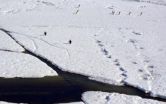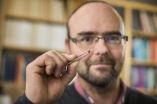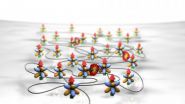(Press-News.org) COLUMBIA, Mo. – When use of a dominant hand is lost by amputation or stroke, a patient is forced to compensate by using the nondominant hand exclusively for precision tasks like writing or drawing. Presently, the behavioral and neurological effects of chronic, forced use of the nondominant hand are largely understudied and unknown. Now, researchers at the University of Missouri have shed light on ways in which a patient compensates when losing a dominant hand and suggest new and improved rehabilitation techniques for those suffering from amputation or stroke.
"Half of the work in our lab focuses on amputees, particularly upper limb amputees, who are out of the acute phase of their recoveries; the other half involves those who have suffered the loss of function due to stroke or neurological disorders," said Scott Frey, professor of psychological sciences and director of the Brain Imaging Center at MU. "Our project analyzed the consequences of losing your dominant hand and how behaviors change for amputees. We also used functional magnetic resonance imaging (fMRI) to study brain function in people adapting to those situations. Our hope is that by studying how amputees cope in these circumstances, we can help improve rehabilitation methods and quality of life in patients facing this loss."
In the study, amputees forced to use nondominant hands performed simple drawing tests and were checked for speed and accuracy. Frey and Benjamin Philip, a postdoctoral research fellow in the Department of Psychological Sciences at MU, found that individuals who were forced to compensate with their nondominant left hands actually performed precision tasks as well as the control group did with their dominant right hands.
The same tests were then conducted under fMRI so that brain function could be observed. Researchers found that the areas formerly devoted to motor and sensory functions of the amputated hand actually contributed to compensation for the loss on the nondominant side.
"Most people know that the left side of your brain controls the right hand and vice versa," Frey said. "For example, if you're right-handed and you're writing or drawing, the left sensory and motor areas show increased activity. We found that when amputees were forced to use their nondominant hands for years or decades, they exhibited performance-related increases in both the right and left hemispheres. In other words, their ability to compensate with the left hand appears to involve exploiting brain mechanisms that previously were devoted to controlling their now absent dominant hands. This compensatory reorganization raises the hope that, through targeted training, non-dominant hand functions can be vastly improved, enabling a better quality of life for those who have lost dominant hand functions due to bodily or brain injury or disease."
Although more work is needed, Frey specifically suggests that his team's work on amputees may inform rehabilitation of stroke patients who do not regain precision control of the dominant hand during acute and subacute phases of recovery. For some patients in the chronic phase of recovery, which is the first 7-18 months following a stroke, it may make sense to train the less affected nondominant side.
Frey's study, "Compensatory changes accompanying chronic forced use of the nondominant hand by unilateral amputees," was published in the Journal of Neuroscience, and was funded by a Department of Defense grant. Frey is the Miller Family Chair in Cognitive Neuroscience and holds a joint appointment as an adjunct professor in the Departments of Neurology, Psychiatry and Physical Medicine and Rehabilitation in the School of Medicine at MU.
INFORMATION:
MU study suggests new rehabilitation methods for amputees and stroke patients
Research on amputees with chronic dominant hand loss may inform rehabilitation of stroke patients
2014-03-12
ELSE PRESS RELEASES FROM THIS DATE:
Stem cells inside sutures could improve healing in Achilles tendon injuries
2014-03-12
Los Angeles, CA (March 12, 2014) Researchers have found that sutures embedded with stem cells led to quicker and stronger healing of Achilles tendon tears than traditional sutures, according to a new study published in the March 2014 issue of Foot & Ankle International (published by SAGE).
Achilles tendon injuries are common for professional, collegiate and recreational athletes. These injuries are often treated surgically to reattach or repair the tendon if it has been torn. Patients have to keep their legs immobilized for a while after surgery before beginning their ...
Computer model predicts vastly different ecosystem in Antarctica's Ross Sea in the coming century
2014-03-12
The Ross Sea, a major, biologically productive Antarctic ecosystem, "clearly will be extensively modified by future climate change" in the coming decades as rising temperatures and changing wind patterns create longer periods of ice-free open water, affecting the life cycles of both predators and prey, according to a paper published by researchers funded by the National Science Foundation (NSF).
To make their predictions, the researchers used information drawn from the Regional Ocean Modeling System, a computer model of sea-ice, ocean, atmosphere and ice-shelf interactions. ...
NASA sees ex-Tropical Cyclone Gillian in Australia's Gulf of Carpentaria
2014-03-12
Tropical Cyclone Gillian made landfall on the western Cape York Peninsula of Queensland, Australia, weakened and has now meandered back over water. On March 12, NASA-NOAA's Suomi NPP satellite captured an image of the remnants in the southern Gulf of Carpentaria.
On March 12 at 0600 UTC/2 a.m. EST, the remnants of Tropical Cyclone Gillian were located near 16.0 south and 141.1 east, about 115 nautical miles/ 132.3 miles/213 km east-northeast of Mornington Island in the Gulf of Carpentaria. According to the Joint Typhoon Warning Center or JTWC maximum sustained surface ...
NASA sees Tropical Cyclone Lusi over Vanuatu
2014-03-12
Tropical Cyclone Lusi reached hurricane force as NASA's Aqua satellite passed overhead early on March 12.
The Moderate Resolution Imaging Spectroradiometer or MODIS instrument aboard NASA's Aqua satellite captured a visible image of Tropical Cyclone Lusi that showed the storm's western quadrant affecting Vanuatu on March 12 at 02:05 UTC. In the MODIS image, Lusi had the distinct comma shape of a mature tropical cyclone, however no eye was visible. However, animated multispectral satellite imagery does show a ragged eye with tightly curved bands of thunderstorms wrapping ...
Sound trumps meaning in first language learning
2014-03-12
(Washington, DC) – A new study reveals that four-to-seven-year-old children rely on the sounds of new nouns more than on their meaning when assigning them to noun classes, even though the meaning is more predictive of noun class in the adult language. This finding reveals that children's sensitivity to their linguistic environment does not line up with objective measures of informativity, highlighting the active role that children play in selecting the data from which they learn language.
The study, "Statistical Insensitivity in the Acquisition of Tsez Noun Classes," ...
Good vibes for catalytic chemistry
2014-03-12
SALT LAKE CITY, March 12, 2014 – University of Utah chemists discovered how vibrations in chemical bonds can be used to predict chemical reactions and thus design better catalysts to speed reactions that make medicines, industrial products and new materials.
"The vibrations alone are not adequate, but combined with other classical techniques in physical organic chemistry, we are able to predict how reactions can occur," says chemistry professor Matt Sigman, senior author of the study in the Thursday, March 13, issue of the journal Nature.
"This should be applicable ...
IRX3 is likely the 'fat gene'
2014-03-12
Mutations within the gene FTO have been implicated as the strongest genetic determinant of obesity risk in humans, but the mechanism behind this link remained unknown. Now, an international team of scientists has discovered that the obesity-associated elements within FTO interact with IRX3, a distant gene on the genome that appears to be the functional obesity gene. The FTO gene itself appears to have only a peripheral effect on obesity. The study appears online March 12 in Nature.
"Our data strongly suggest that IRX3 controls body mass and regulates body composition," ...
Building new drugs just got easier
2014-03-12
LA JOLLA, CA—March 12, 2014—Scientists at The Scripps Research Institute (TSRI) have developed a method for modifying organic molecules that significantly expands the possibilities for developing new pharmaceuticals and improving old ones.
"This is a technology that can be applied directly to many medicinally relevant compounds," said Jin-Quan Yu, a professor in TSRI's Department of Chemistry and the senior author of the new report, which appears in Nature March 13, 2014.
The innovation makes it easier to modify existing organic compounds by attaching biologically active ...
Water-rich gem points to vast 'oceans' beneath the Earth: UAlberta study
2014-03-12
A University of Alberta diamond scientist has found the first terrestrial sample of a water-rich gem that yields new evidence about the existence of large volumes of water deep beneath the Earth.
An international team of scientists led by Graham Pearson, Canada Excellence Research Chair in Arctic Resources at the U of A, has discovered the first-ever sample of a mineral called ringwoodite. Analysis of the mineral shows it contains a significant amount of water—1.5 per cent of its weight—a finding that confirms scientific theories about vast volumes of water trapped 410 ...
Quantum chaos in ultracold gas discovered
2014-03-12
The team of Francesca Ferlaino, Institute for Experimental Physics of the University of Innsbruck, Austria, has experimentally shown chaotic behavior of particles in a quantum gas. "For the first time we have been able to observe quantum chaos in the scattering behavior of ultracold atoms," says an excited Ferlaino. The physicists used random matrix theory to confirm their results, thus asserting the universal character of this statistical theory. Nobel laureate Eugene Wigner formulated random matrix theory to describe complex systems in the 1950s. Although interactions ...
LAST 30 PRESS RELEASES:
The impact of family dynamics on eating behaviour – how going home for Christmas can change how you eat
Tracing the quick synthesis of an industrially important catalyst
New software sheds light on cancer’s hidden genetic networks
UT Health San Antonio awarded $3 million in CPRIT grants to bolster cancer research and prevention efforts in South Texas
Third symposium spotlights global challenge of new contaminants in China’s fight against pollution
From straw to soil harmony: International team reveals how biochar supercharges carbon-smart farming
Myeloma: How AI is redrawing the map of cancer care
Manhattan E. Charurat, Ph.D., MHS invested as the Homer and Martha Gudelsky Distinguished Professor in Medicine at the University of Maryland School of Medicine
Insilico Medicine’s Pharma.AI Q4 Winter Launch Recap: Revolutionizing drug discovery with cutting-edge AI innovations, accelerating the path to pharmaceutical superintelligence
Nanoplastics have diet-dependent impacts on digestive system health
Brain neuron death occurs throughout life and increases with age, a natural human protein drug may halt neuron death in Alzheimer’s disease
SPIE and CLP announce the recipients of the 2025 Advanced Photonics Young Innovator Award
Lessons from the Caldor Fire’s Christmas Valley ‘Miracle’
Ant societies rose by trading individual protection for collective power
Research reveals how ancient viral DNA shapes early embryonic development
A molecular gatekeeper that controls protein synthesis
New ‘cloaking device’ concept to shield sensitive tech from magnetic fields
Researchers show impact of mountain building and climate change on alpine biodiversity
Study models the transition from Neanderthals to modern humans in Europe
University of Phoenix College of Doctoral Studies releases white paper on AI-driven skilling to reduce burnout and restore worker autonomy
AIs fail at the game of visual “telephone”
The levers for a sustainable food system
Potential changes in US homelessness by ending federal support for housing first programs
Vulnerability of large language models to prompt injection when providing medical advice
Researchers develop new system for high-energy-density, long-life, multi-electron transfer bromine-based flow batteries
Ending federal support for housing first programs could increase U.S. homelessness by 5% in one year, new JAMA study finds
New research uncovers molecular ‘safety switch’ shielding cancers from immune attack
Bacteria resisting viral infection can still sink carbon to ocean floor
Younger biological age may increase depression risk in older women during COVID-19
Bharat Innovates 2026 National Basecamp Showcases India’s Most Promising Deep-Tech Ventures
[Press-News.org] MU study suggests new rehabilitation methods for amputees and stroke patientsResearch on amputees with chronic dominant hand loss may inform rehabilitation of stroke patients







